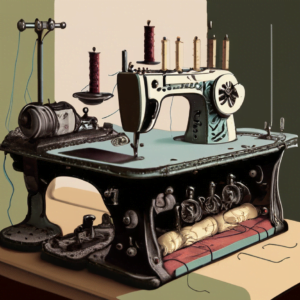
Introduction
In the realm of sewing, vintage sewing machines hold a special place. These magnificent machines, with their timeless craftsmanship and nostalgic charm, evoke a sense of nostalgia and take us back to an era when sewing was an art form in itself. Vintage sewing machines are not only a collector’s delight but also a valuable asset for enthusiasts, artists, and seamstresses seeking the highest level of precision and durability. In this comprehensive guide, we delve into the world of vintage sewing machines, exploring their history, functionality, maintenance, and the reasons why they continue to captivate our hearts.
Vintage Sewing Machines: A Glimpse into the Past

Vintage sewing machines are a testament to the ingenuity and skill of their creators. These machines, typically manufactured between the late 19th century and mid-20th century, were crafted with exceptional attention to detail and durability. They were built to last, utilizing robust materials and intricate mechanisms that have stood the test of time.
The Evolution of Vintage Sewing Machines
The journey of this machines began with the invention of the first practical sewing machine by Elias Howe in 1846. This groundbreaking invention paved the way for subsequent advancements in sewing technology, leading to the creation of more refined and intricate machines.
In the late 19th century, renowned these machine companies such as Singer, Pfaff, and Brother emerged, introducing a new era of sewing machines. These companies competed fiercely to offer innovative features and improve the overall sewing experience.
Features of Vintage Sewing Machines
It boasted an array of features that set them apart from their modern counterparts. One notable feature is their cast-iron construction, which lends them exceptional stability and durability. The solid build of these machines ensured minimal vibration during operation, resulting in precise and consistent stitches.
Another distinctive feature of this machines is their intricate mechanical design. These machines were operated using a foot pedal, which controlled the movement of the needle and the feed dogs. The mechanical precision of vintage machines allowed for intricate stitching patterns and the ability to handle a wide range of fabrics.
The Timeless Appeal of Vintage Sewing Machines

It hold a special place in the hearts of sewing enthusiasts, collectors, and artists alike. Their enduring appeal can be attributed to several factors.
Nostalgia and Aesthetics
It exude a nostalgic charm that transports us to a bygone era. The beautifully crafted details, ornate decals, and elegant designs add a touch of vintage elegance to any sewing space. Owning and using a vintage sewing machine not only provides a functional tool but also serves as a unique piece of decor that sparks conversation and adds character to a room.
Craftsmanship and Durability
One of the key reasons vintage sewing machines continue to fascinate is their exceptional craftsmanship and durability. These machines were built to withstand the test of time, often outlasting several generations. With proper care and maintenance, vintage sewing machines can still deliver exceptional sewing performance today, proving that they were truly built to last.
Superior Stitch Quality
Vintage sewing machines are revered for their ability to produce impeccable stitches. The mechanical design and precision engineering of these machines result in consistent stitch lengths and superior stitch quality. Seamstresses and artists who value the utmost precision in their work often turn to vintage sewing machines to achieve flawless results.
Maintenance and Care for Vintage Sewing Machines
To preserve the functionality and beauty of vintage sewing machines, regular maintenance and care are crucial. Here are some essential tips to keep these timeless machines in pristine condition:
- Cleaning and Lubrication: Regularly clean the machine using a soft brush and lint-free cloth to remove dust and debris. Lubricate the moving parts with high-quality sewing machine oil to ensure smooth operation.
- Storage: Store the vintage sewing machine in a dry and dust-free environment. Cover it with a protective case or fabric to prevent dust accumulation and potential damage.
- Periodic Servicing: Consider having the machine serviced by a professional to ensure proper alignment of the mechanisms and address any potential issues.
- Avoid Excessive Force: Handle the machine with care and avoid exerting excessive force on delicate parts. Gentle and precise operation will help maintain its longevity.
Frequently Asked Questions (FAQs)
Q: Can vintage sewing machines handle modern fabrics?
A: Yes, vintage sewing machines can handle a wide range of modern fabrics. However, it is essential to choose the appropriate needle and thread for each fabric type to ensure optimal results.
Q: Are vintage sewing machines suitable for beginners?
A: Vintage sewing machines can be a great option for beginners due to their mechanical simplicity and ease of use. They provide an excellent opportunity to learn the basics of sewing while enjoying the charm of vintage craftsmanship.
Q: Where can I find replacement parts for vintage sewing machines?
A: Several online marketplaces and specialty sewing machine stores offer a wide selection of replacement parts for vintage sewing machines. It is important to research and choose reputable sources to ensure the authenticity and quality of the parts.
Q: What should I consider when purchasing a vintage sewing machine?
A: When purchasing a vintage sewing machine, consider factors such as the condition of the machine, availability of replacement parts, and the reputation of the brand. It is also advisable to test the machine before making a purchase to ensure its functionality.
Q: Are vintage sewing machines valuable collectibles?
A: Vintage sewing machines can indeed be valuable collectibles, especially those with rare or unique features. The value of a vintage sewing machine depends on factors such as its age, condition, brand, and historical significance.
Q: Can vintage sewing machines be used for quilting?
A: Yes, vintage sewing machines can be used for quilting. Their sturdy construction and ability to handle thick fabrics make them suitable for quilting projects. However, it is important to ensure that the machine has the necessary attachments and settings for quilting purposes.

